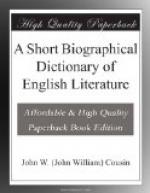LAING, MALCOLM (1762-1818).—Was a country gentleman in Orkney. He completed Henry’s History of Great Britain, and wrote a History of Scotland from the Union of the Crowns to the Union of the Kingdoms (1802). He was an assailant of the authenticity of the Ossianic poems, and wrote a dissertation on the Participation of Mary Queen of Scots in the Murder of Darnley. He did much to improve the agriculture of Orkney.
LAMB, LADY CAROLINE (1785-1828).—Novelist, dau. of 3rd Earl of Bessborough, m. the Hon. William Lamb, afterwards Lord Melbourne and Prime Minister. She wrote three novels, which, though of little literary value, attracted much attention. The first of these, Glenarvon (1816), contained a caricature portrait of Lord Byron, with whom the authoress had shortly before been infatuated. It was followed by Graham Hamilton (1822), and Ada Reis (1823). Happening to meet the hearse conveying the remains of Byron, she became unconscious, and fell into mental alienation, from which she never recovered.
LAMB, CHARLES (1775-1834).—Essayist and poet, was b. in London, his f. being confidential clerk to Samuel Salt, one of the benchers of the Inner Temple. After being at a school in the neighbourhood, he was sent by the influence of Mr. Salt to Christ’s Hospital, where he remained from 1782-89, and where he formed a lifelong friendship with Coleridge. He was then for a year or two in the South Sea House, where his elder brother John was a clerk. Thence he was in 1792 transferred to the India House, where he remained until 1825, when he retired with a pension of two-thirds of his salary. Mr. Salt d. in 1792, and the family, consisting of the f., mother, Charles, and his sister Mary, ten years his senior, lived together in somewhat straitened circumstances. John, comparatively well off, leaving them pretty much to their own resources. In 1796 the tragedy of L.’s life occurred. His sister Mary, in a sudden fit of insanity, killed her mother with a table-knife. Thenceforward, giving up a marriage to which he was looking forward, he devoted himself to the care of his unfortunate sister, who became, except when separated from him by periods of aberration, his lifelong and affectionate companion—the “Cousin Bridget” of his essays. His first literary appearance was a contribution of four sonnets to Coleridge’s Poems on Various Subjects (1796). Two years later he pub., along with his friend Charles Lloyd, Blank Verse, the little vol. including The Old Familiar Faces, and others of his best known poems, and his romance, Rosamund Gray, followed in the same year. He then turned to the drama, and produced John Woodvil, a tragedy, and Mr. H., a farce, both failures, for although the first had some echo of the Elizabethan music, it had no dramatic force. Meantime the brother and sister were leading a life clouded by




